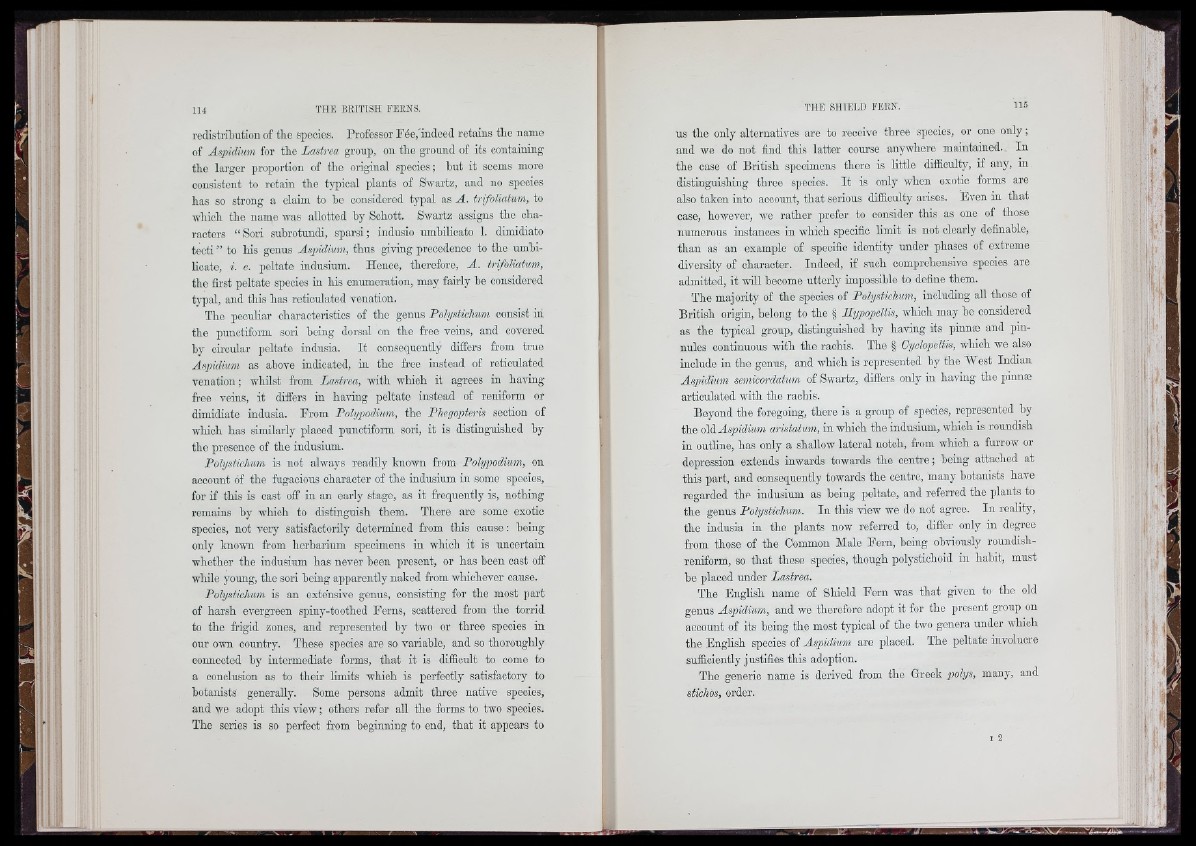
redistribution of tbe species. Professor Fée,'indeed retains tbe name
of Aspidium for tho Lastrea group, on the ground of its containing
the larger proportion of the original species; hut it seems more
consistent to retain tho tj^pioal plants of Swartz, and no species
has so strong a claim to he considered typal as A . trifoliatum, to
which the name was allotted by Schott. Swartz assigns the characters
“ Sori suhrotundi, sparsi; indusio umbilicato 1 . dimidiato
teoti ” to his genus Aspidium, thus giving preoodence to the umbi-
lioate, i. e. peltate indusium. Hence, therefore, A . trifoliatum,
the first peltate species in his enumeration, may fairly he considered
typal, and this has reticulated venation.
The peculiar characteristics of the genus Polysticlmm consist in
the punotiform sori boing dorsal on the free veins, and covered
hy circular peltate indusia. I t consequently differs from true
Aspidium as above indicated, in the free instead of reticulated
venation ; whilst from Lastrea, with which it agrees in having-
free veins, it differs in having peltate instead of reniform or
dimidiate indusia. From Polypodium, the Phegopteris section of
which has similarly placed punctiform sori, it is distinguished by
the presence of the indusium.
Polysticlmm is not always readily known from Polypodium, on
account of the fugacious character of the indusinm in some species,
for if this is cast off in an early stage, as it frequently is, nothing
remains by which to distinguish them. There are some exotic
species, not very satisfactorily determined from this cause : being
only kno-wn from herbarium specimens in which it is uncertain
whether the indusium has never been present, or has been oast off
while young, the sori being apparently naked from whichever cause.
Polystichum is an extensive genus, consisting for the most part
of harsh evergreen spiny-toothed Forns, scattered from the torrid
to the frigid zones, and represented by two or three species in
our o-wn country. These species aro so variable, and so thoroughly
connected by intermediate forms, that it is difficult to come to
a conclusion as to their limits which is perfectly satisfactory to
botanists generally. Some persons admit three native species,
and we adopt this -view ; others refer all the forms to two species.
The series is so perfect from beginning to end, that it appears to
us the only alternatives are to receive throe species, or one only ;
and we do not find this latter course anywhere maintained. In
the case of British specimens there is little difficulty, if any, in
distinguishing three species. I t is only when exotic forms are
also taken into account, that serious difficulty arises. Fven in that
case, however, we rather prefer to consider this as ono of those
numerous instances in which specific limit is not clearly definable,
than as an example of specific identity under phases of extreme
diversity of character. Indeed, if such oomprcheusive species are
admitted, it will become utterly impossible to define them.
The majority of the species of Polystichum, including all those of
British origin, belong to the § Ilypopeltis, which may he considorod
as the typical group, distinguished hy having its pinnæ and pinnules
coutinuous with the raohis. The § Cyclopeltis, which we also
include in the genus, and which is represented hy tho W est Indian
Aspidium semicordatum of Swartz, differs only in haring tho pinnæ
articulated with the raohis.
Beyond the foregoing, there is a group of species, represented by
the oAAspidium aristatum, in which the indusium, which is roundish
in outline, has only a shallow lateral notch, from which a furrow or
depression extends inwards towards the centre; being attached at
this part, and consequently towards the centre, many botanists have
regarded the indusium as being peltate, and referred the plants to
the genus Polystichum. In this view we do not agree. In reality,
the indusia in the plants now referred to, differ only in degree
from those of the Common Male Fern, being ohriously roundish-
reniform, so that these species, though polystichoid in habit, must
be placed under Lastrea.
The English name of Shield Fern was that given to the old
genus Aspidium, and we therefore adopt it for the present group on
account of its being the most typical of the two genera under which
the English species of Aspidium are placed. Tho peltate involucre
sufficiently justifies this adoption.
The generic name is derived from the Greek polys, many, and
stichos, order.
t í ':
i -71